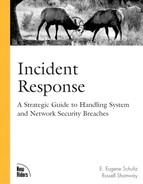Book Description
This book teaches readers what they need to know to not only set up an incident response effort, but also how to improve existing incident response efforts. The book provides a comprehensive approach to incident response, covering everything necessary to deal with all phases of incident response effectively ¿ spanning from pre-incident conditions and considerations to the end of an incident.
Although technical considerations, (e.g. the particular binaries in Unix and Linux and dynamically linked libraries in Windows NT and Windows 2000) that need to be inspected in case they are corrupted, the types of logging data available in major operating systems and how to interpret it to obtain information about incidents, how network attacks can be detected on the basis of information contained in packets, and so on ¿ the major focus of this book is on managerial and procedural matters. Incident Response advances the notion that without effective management, incident response cannot succeed.
Book Description
This book teaches readers what they need to know to not only set up an incident response effort, but also how to improve existing incident response efforts. The book provides a comprehensive approach to incident response, covering everything necessary to deal with all phases of incident response effectively ¿ spanning from pre-incident conditions and considerations to the end of an incident.
Although technical considerations, (e.g. the particular binaries in Unix and Linux and dynamically linked libraries in Windows NT and Windows 2000) that need to be inspected in case they are corrupted, the types of logging data available in major operating systems and how to interpret it to obtain information about incidents, how network attacks can be detected on the basis of information contained in packets, and so on ¿ the major focus of this book is on managerial and procedural matters. Incident Response advances the notion that without effective management, incident response cannot succeed.
Table of Contents
- Copyright
- About the Authors
- About the Technical Reviewers
- Acknowledgments
- Tell Us What You Think
- Introduction
- An Introduction to Incident Response
- Risk Analysis
- A Methodology for Incident Response
- Forming and Managing an Incident Response Team
- Organizing for Incident Response
- Tracing Network Attacks
- Legal Issues
- Forensics I
- Forensics II
- Responding to Insider Attacks
- The Human Side of Incident Response
- Traps and Deceptive Measures
- Future Directions in Incident Response
- RFC-2196
- Incident Response and Reporting Checklist
